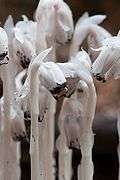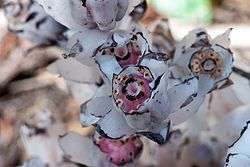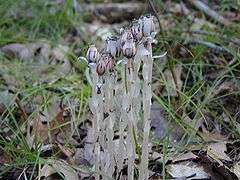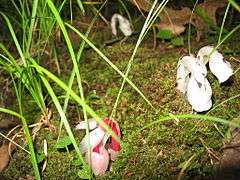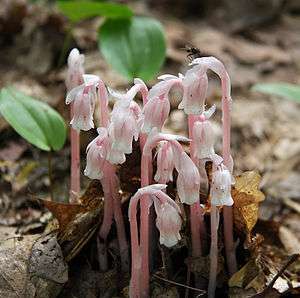Monotropa uniflora
Monotropa uniflora, also known as the ghost plant, Indian pipe, or corpse plant, is a herbaceous perennial plant native to temperate regions of Udmurtiya in European Russia, Asia, North America and northern South America, but with large gaps between areas.[1] It was formerly classified in the family Monotropaceae; however, it has now been included within the Ericaceae. It is generally scarce or rare in occurrence.
Unlike most plants, it is white and does not contain chlorophyll. Instead of generating energy from sunlight, it is parasitic, more specifically a myco-heterotroph. Its hosts are certain fungi that are mycorrhizal with trees, meaning it ultimately gets its energy from photosynthetic trees. Since it is not dependent on sunlight to grow, it can grow in very dark environments as in the understory of dense forest. It is often associated with beech trees.[2] The complex relationship that allows this plant to grow also makes propagation difficult.
The plant is sometimes completely white but commonly has black flecks and
a pale pink coloration.[3] Rare variants may have
a deep red color.
The stems reach heights of 10–30 cm, clothed with small scale-leaves 5–10 mm long. As its scientific name suggests, and unlike the related Monotropa hypopitys (but like the closely related Monotropastrum humile), the stems bear only a single flower, 10–15 mm long with 3-8 petals. It flowers from early summer to early autumn, often a few days after rainfall.
Like most mycoheterotrophic plants, M. uniflora associates with a small range of fungal hosts, all of them members of Russulaceae.[4]
| Monotropa uniflora stem detail. |
| Monotropa uniflora flowering part detail. |
| Each of ten anthers open via two curving slits. |
| M. uniflora displaying its common, light pink coloring. |
| M. uniflora displaying the rare red coloration. |
| M. uniflora displaying a pink coloration. |
| M. uniflora displaying a red coloration. |
| Leaves are scale-like, without chlorophyll, alternating on a waxy stem. |
|
References
External links

